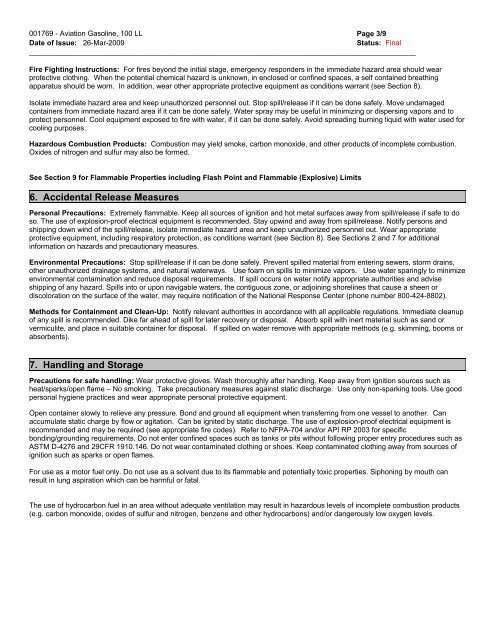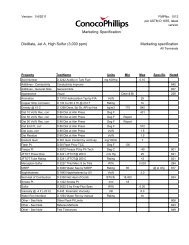COP Fuels Tests DH - Phillips 66 Aviation
COP Fuels Tests DH - Phillips 66 Aviation
COP Fuels Tests DH - Phillips 66 Aviation
You also want an ePaper? Increase the reach of your titles
YUMPU automatically turns print PDFs into web optimized ePapers that Google loves.
001769 - <strong>Aviation</strong> Gasoline, 100 LL<br />
Date of Issue: 26-Mar-2009<br />
________________________________________________________________________________________________<br />
Fire Fighting Instructions: For fires beyond the initial stage, emergency responders in the immediate hazard area should wear<br />
protective clothing. When the potential chemical hazard is unknown, in enclosed or confined spaces, a self contained breathing<br />
apparatus should be worn. In addition, wear other appropriate protective equipment as conditions warrant (see Section 8).<br />
Isolate immediate hazard area and keep unauthorized personnel out. Stop spill/release if it can be done safely. Move undamaged<br />
containers from immediate hazard area if it can be done safely. Water spray may be useful in minimizing or dispersing vapors and to<br />
protect personnel. Cool equipment exposed to fire with water, if it can be done safely. Avoid spreading burning liquid with water used for<br />
cooling purposes.<br />
Hazardous Combustion Products: Combustion may yield smoke, carbon monoxide, and other products of incomplete combustion.<br />
Oxides of nitrogen and sulfur may also be formed.<br />
See Section 9 for Flammable Properties including Flash Point and Flammable (Explosive) Limits<br />
6. Accidental Release Measures<br />
Personal Precautions: Extremely flammable. Keep all sources of ignition and hot metal surfaces away from spill/release if safe to do<br />
so. The use of explosion-proof electrical equipment is recommended. Stay upwind and away from spill/release. Notify persons and<br />
shipping down wind of the spill/release, isolate immediate hazard area and keep unauthorized personnel out. Wear appropriate<br />
protective equipment, including respiratory protection, as conditions warrant (see Section 8). See Sections 2 and 7 for additional<br />
information on hazards and precautionary measures.<br />
Environmental Precautions: Stop spill/release if it can be done safely. Prevent spilled material from entering sewers, storm drains,<br />
other unauthorized drainage systems, and natural waterways. Use foam on spills to minimize vapors. Use water sparingly to minimize<br />
environmental contamination and reduce disposal requirements. If spill occurs on water notify appropriate authorities and advise<br />
shipping of any hazard. Spills into or upon navigable waters, the contiguous zone, or adjoining shorelines that cause a sheen or<br />
discoloration on the surface of the water, may require notification of the National Response Center (phone number 800-424-8802).<br />
Methods for Containment and Clean-Up: Notify relevant authorities in accordance with all applicable regulations. Immediate cleanup<br />
of any spill is recommended. Dike far ahead of spill for later recovery or disposal. Absorb spill with inert material such as sand or<br />
vermiculite, and place in suitable container for disposal. If spilled on water remove with appropriate methods (e.g. skimming, booms or<br />
absorbents).<br />
7. Handling and Storage<br />
Page 3/9<br />
Status: Final<br />
Precautions for safe handling: Wear protective gloves. Wash thoroughly after handling. Keep away from ignition sources such as<br />
heat/sparks/open flame – No smoking. Take precautionary measures against static discharge. Use only non-sparking tools. Use good<br />
personal hygiene practices and wear appropriate personal protective equipment.<br />
Open container slowly to relieve any pressure. Bond and ground all equipment when transferring from one vessel to another. Can<br />
accumulate static charge by flow or agitation. Can be ignited by static discharge. The use of explosion-proof electrical equipment is<br />
recommended and may be required (see appropriate fire codes). Refer to NFPA-704 and/or API RP 2003 for specific<br />
bonding/grounding requirements. Do not enter confined spaces such as tanks or pits without following proper entry procedures such as<br />
ASTM D-4276 and 29CFR 1910.146. Do not wear contaminated clothing or shoes. Keep contaminated clothing away from sources of<br />
ignition such as sparks or open flames.<br />
For use as a motor fuel only. Do not use as a solvent due to its flammable and potentially toxic properties. Siphoning by mouth can<br />
result in lung aspiration which can be harmful or fatal.<br />
The use of hydrocarbon fuel in an area without adequate ventilation may result in hazardous levels of incomplete combustion products<br />
(e.g. carbon monoxide, oxides of sulfur and nitrogen, benzene and other hydrocarbons) and/or dangerously low oxygen levels.




